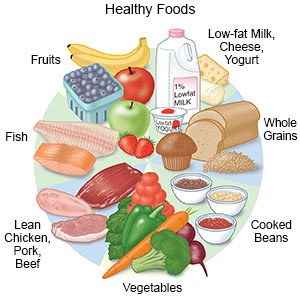Healthy Meal Plan for Children
Medically reviewed by Drugs.com. Last updated on Aug 4, 2025.
AMBULATORY CARE:
Help your child follow
a healthy meal plan. Be a positive role model for your child by following a healthy lifestyle. Your child learns from your behavior. Your child will be more likely to make changes if he or she sees you make changes. Changes may help to improve the health of everyone in the family. Try to make only a few changes at a time. It may be hard for your child to make too many changes all at once. During one week, you could serve a healthy breakfast. You could add another new change each week.
Give your child 3 meals and 1 or 2 snacks each day:
Offer your child a variety of healthy foods such as whole grains, vegetables, fruits, low-fat dairy, and lean protein foods. Do not force your child to eat all the food on his or her plate. Allow your child to decide when he or she is full. This can help him or her learn to stop eating when he or she is full.
 |
Make sure your family eats breakfast:
Skipping breakfast often leads to overeating later in the day. An example of a healthy breakfast would be low-fat milk (1% or skim) with a low-sugar cereal and fruit. Some examples of low-sugar cereals are corn flakes, bran flakes, and oatmeal.
Pack a healthy lunch:
Pack baby carrots or pretzels instead of potato chips in your child's lunch box. You can also add fruit, low-fat pudding, or low-fat yogurt instead of cookies.
Related medications
Make healthy choices for dinner:
Make it a habit to add vegetables to your family's meals. Include healthy protein foods. Choose beans or other legumes such as split peas or lentils. Choose fish, skinless chicken or turkey, or lean cuts of beef or pork. Cut off any visible fat before you cook the food. Some dessert ideas include fruit dishes, low-fat ice cream, or angel food cake with fresh strawberries.
Decrease calories:
- Cook with less fat. Bake, roast, or poach (cook in simmering liquid) meats instead of frying.
- Limit high-sugar foods. Offer water or low-fat milk instead of soft drinks, fruit juice drinks, and sports drinks. Buy low-sugar cereals and snacks. Ask your healthcare provider for information about how to read food labels.
- Keep healthy snacks handy. Some examples include fruits, vegetables, low-fat popcorn, low-fat yogurt, or fat-free pudding.
- Limit meals at fast food restaurants. When you do eat out, choose restaurants with healthier food choices.
Eat meals together as a family as often as possible:
Do not eat in front of the TV.
Do not give your child food as a reward for good behavior:
For example, do not promise your child a candy if he or she behaves well at the store.
Do not keep food from your child because of poor behavior:
If the family is having dessert, let your child have it also. Teach your child not to use food as a way of handling stress or rewarding success.
© Copyright Merative 2025 Information is for End User's use only and may not be sold, redistributed or otherwise used for commercial purposes.
The above information is an educational aid only. It is not intended as medical advice for individual conditions or treatments. Talk to your doctor, nurse or pharmacist before following any medical regimen to see if it is safe and effective for you.
Further information
Always consult your healthcare provider to ensure the information displayed on this page applies to your personal circumstances.
